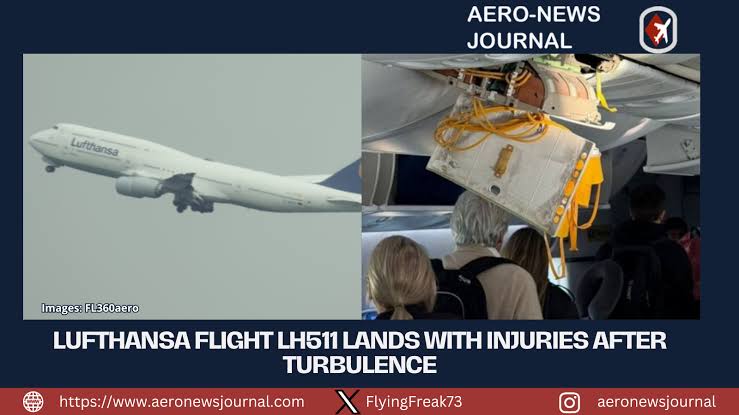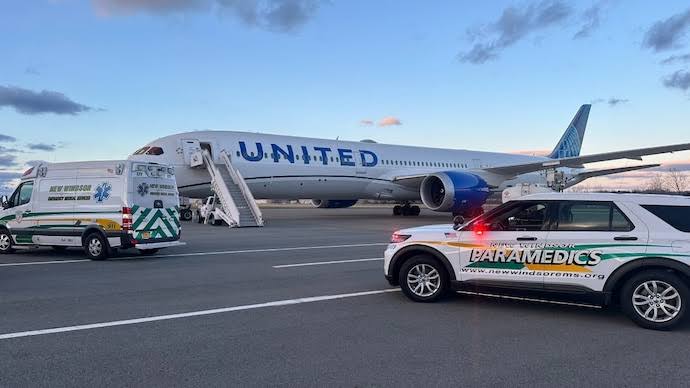Lufthansa Boeing 747-8 Hit by Severe Turbulence Over Atlantic — Many Injured, Aircraft……
Lufthansa Boeing 747-8 Hit by Severe Turbulence Over Atlantic — Many Injured, Aircraft Lands Safely
In a harrowing mid-flight incident that shook passengers and crew alike, a Lufthansa Boeing 747-8 aircraft encountered severe turbulence over the Atlantic Ocean on the night of November 11 to 12, 2024, causing multiple injuries. The flight, operating from Buenos Aires, Argentina to Frankfurt, Germany (Flight LH511), was en route over the Intertropical Convergence Zone — a region known for unpredictable and intense weather phenomena — when the aircraft suddenly hit a violent patch of turbulence.
The Incident
The turbulence struck the aircraft without warning, catching many onboard unprepared. According to Lufthansa and subsequent medical reports, 11 individuals sustained injuries during the incident — five passengers and six crew members. The injuries, fortunately, were classified as minor, though some required immediate medical attention upon landing.
Passengers aboard the flight described the terrifying moment as a sudden jolt that violently shook the plane. Some individuals were thrown from their seats, and unsecured items were sent flying through the cabin. Many of those injured were not wearing seatbelts at the time, underscoring the ever-present safety reminder to remain buckled even when the seatbelt sign is off.
One traveler, recounting the experience in an interview with German media, said:
> “We were watching a movie, and suddenly everything just dropped. Trays flew, glasses shattered, and people screamed. I saw one flight attendant thrown against the ceiling.”
Flight Response and Emergency Measures
Despite the chaos, the cockpit crew maintained full control of the aircraft. The turbulence, while violent, did not damage the aircraft’s structural integrity or systems. Lufthansa later confirmed that the flight continued toward its destination and landed safely in Frankfurt Airport, albeit with emergency services already alerted and waiting.
Once the aircraft touched down in Frankfurt, ambulances and medical teams were standing by to assess and treat the injured. Most of the affected passengers were treated on-site and released, while a few crew members were taken to nearby hospitals for further evaluation.
Lufthansa issued a brief statement following the incident:
> “Flight LH511 from Buenos Aires to Frankfurt experienced a sudden encounter with severe turbulence on November 12, 2024. Safety remains our top priority, and we commend our crew for their professionalism in managing the situation. We extend our care and support to all affected passengers and crew.”
What Caused the Turbulence?
Meteorological experts pointed out that the aircraft was flying through the Intertropical Convergence Zone (ITCZ) — a belt around the Earth near the equator where the trade winds of the Northern and Southern Hemispheres meet. The area is notorious for unpredictable weather, including strong thunderstorms and rapidly changing wind currents.
Though turbulence is a common occurrence in air travel, the severity experienced on this flight was considered “moderate to severe”, which is relatively rare. According to aviation specialists, this may have been a case of clear-air turbulence (CAT), which can’t be detected by onboard radar and often occurs in cloudless skies — making it one of the most dangerous types.
Dr. Helmut Kraus, an aviation meteorologist from the German Meteorological Service (DWD), explained:
> “Clear-air turbulence is particularly hazardous because it cannot be seen and often occurs suddenly. In tropical convergence zones, the atmospheric instability is amplified, which may explain the incident Lufthansa faced.”
Passenger Experience and Aftermath
As news of the incident spread, passengers began sharing their experiences online. Social media was quickly filled with photos of the disarray inside the cabin — overturned food trays, broken items, and even scattered oxygen masks. Several flyers praised the flight attendants’ quick actions, stating they remained calm and immediately administered first aid where necessary.
One traveler posted on X (formerly Twitter):
> “The turbulence was unreal. I’ve flown dozens of times, and I’ve never felt fear like that. Thank you to the Lufthansa staff for staying composed.”
In the wake of the incident, Lufthansa offered counseling services and compensation to those injured or affected. The airline also announced that they would review their flight path procedures and enhance pilot briefings when transiting through known high-risk zones like the ITCZ.
Airline Safety and Industry Reactions
This incident adds to a growing list of turbulence-related events affecting long-haul flights in recent years. While aircraft are designed to withstand extreme conditions, the aviation industry is becoming increasingly concerned about the increased frequency and severity of turbulence, possibly linked to climate change and shifting jet stream patterns.
Airline analyst Sophie Baumgarten, speaking to Der Spiegel, noted:
> “Severe turbulence incidents are still relatively rare, but we’re seeing a trend upward. Airlines need to invest more in predictive tools and perhaps rethink routing through sensitive zones during certain seasons.”
Despite the incident, Lufthansa reaffirmed its commitment to passenger safety and noted that their aircraft — particularly wide-body jets like the Boeing 747-8 — are rigorously maintained and engineered to withstand extraordinary aerodynamic stresses.
Safety Tips for Passengers
In light of this event, aviation experts are once again urging passengers to keep seatbelts fastened at all times during flight, even if the sign is turned off. Most injuries in turbulence events happen because individuals are unrestrained or moving around the cabin.
Here are some standard turbulence safety tips:
Always keep your seatbelt buckled, even when seated during calm conditions.
Store overhead items properly and close bins tightly.
Avoid standing up unless necessary, especially during long-haul flights through unpredictable zones.
Listen to crew instructions and don’t ignore the seatbelt signs.
Conclusion
The Lufthansa turbulence incident over the Atlantic, while terrifying for those involved, thankfully ended without any life-threatening injuries or loss of life. It serves as a stark reminder of the unpredictable nature of air travel — particularly through meteorologically volatile regions like the Intertropical Convergence Zone.
As climate patterns continue to evolve, it’s likely that airlines, passengers, and aviation authorities will need to work together more closely to mitigate the risks associated with airborne turbulence. For now, Lufthansa passengers can take some comfort in the airline’s quick and professional response — and the fact that the aircraft safely completed its journey home.






